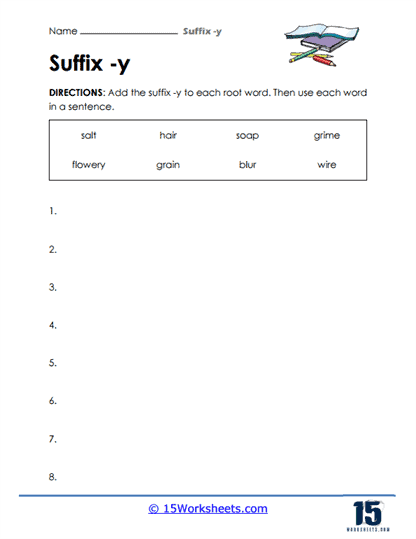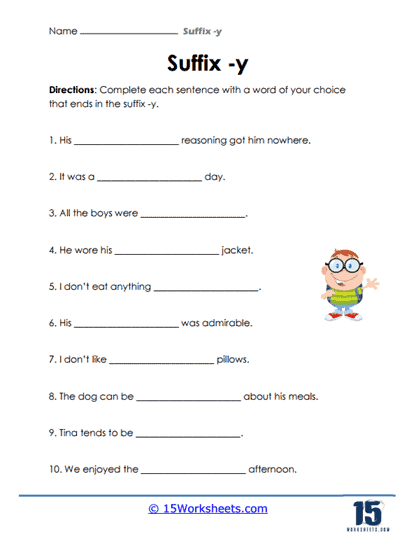Suffix -y Worksheets
About These 15 Worksheets
These worksheets will enhance students’ understanding and use of the suffix “-y” in the English language. These worksheets focus on how adding “-y” to a word can change its meaning and grammatical function, typically turning nouns and verbs into adjectives. The practice of these worksheets is invaluable for students, helping them to grasp more complex aspects of grammar, enrich vocabulary, and improve their overall language skills.
They offer a focused approach to understanding how a single suffix can alter the meaning and grammatical function of a word, enriching students’ vocabulary and enhancing their writing and reading abilities. Through a variety of exercises, these worksheets provide a comprehensive and engaging way for students to explore and master the use of the “-y” suffix, ultimately contributing to their overall proficiency in the English language.
Types of Exercises
Identification Exercises – These exercises involve identifying words that correctly use the suffix “-y”. Students are presented with a list of words, some of which include the “-y” suffix, and they must distinguish these from others. This task enhances their ability to recognize and understand adjectives formed with “-y”. Students are given a list of “-y” adjectives and their definitions, and they must match each word to its correct meaning. This activity is particularly useful for vocabulary expansion and deepening understanding of each word.
Word and Sentence Formation Tasks – In these tasks, students are given base words and are asked to create new words by adding the suffix “-y”. For example, they might turn “cloud” into “cloudy” or “rain” into “rainy”. This not only helps in understanding how the suffix changes the word’s meaning but also its grammatical function. Here, students are asked to create their own sentences using a list of “-y” adjectives. This task encourages creativity and helps students practice using these adjectives in various contexts.
Sentence Completion Exercises – These worksheets present sentences with missing adjectives. Students fill in the blanks with appropriate “-y” adjectives, either from memory or a provided word bank. This exercise is excellent for understanding how these adjectives fit into sentence structures and contexts. In these exercises, students are given sentences that contain misuse of the “-y” suffix. Their task is to identify and correct these errors, which enhances their editing and grammar skills.
Comparing and Contrasting Words with and without “-y” – In this exercise, students are presented with pairs of words, one with the “-y” suffix and one without (e.g., “mess” and “messy”). They compare and contrast these words to understand how their meanings and uses differ. Students sort a mixed list of words into two categories: words that correctly use the “-y” suffix and those that don’t. This exercise reinforces the understanding of how “-y” changes a word and its usage.
Benefits of These Worksheets
Improved Understanding of Word Formation
Regular practice with these worksheets helps students understand how suffixes, particularly “-y”, alter the form and function of words. This knowledge is crucial for developing a more nuanced understanding of word formation and enhances their ability to decode new words they encounter in reading.
Improved Spelling and Vocabulary
Working with suffix -y worksheets helps students understand how the addition of a suffix can change the spelling of a word. This awareness is crucial for accurate spelling, a skill that is fundamental in both written communication and literacy development. Suffix -y worksheets greatly expand a student’s vocabulary. By learning how to add “-y” to various nouns and verbs, students not only learn new adjectives but also understand the broader concept of how words can be transformed and expanded in English.
Enhanced Writing Skills
As students become more proficient in using “-y” adjectives, their writing skills improve. They learn to describe scenes, emotions, and objects more vividly and accurately, making their writing more engaging and expressive. Practicing with these worksheets improves students’ grammar skills. They learn where and how to use adjectives correctly in sentences, which is fundamental for constructing grammatically sound and coherent sentences.
Better Reading Comprehension
Understanding the use of “-y” in words helps students grasp the meaning of texts more effectively. When they encounter “-y” adjectives while reading, they can deduce the meaning of these words based on their root words, enhancing their overall comprehension.
Enhanced Critical Thinking and Problem-Solving Skills
Some exercises, particularly those involving correction of mistakes or word sorting, require critical thinking and problem-solving skills. Students must analyze the use of words within a context, decide if they are used correctly, and determine how to fix errors. Through the various exercises, students become more sensitive to language nuances. They learn to appreciate the subtleties of meaning that different suffixes can bring to words, fostering a deeper appreciation for language and its complexities.
The Most Commonly Used Words With the Suffix “-y”
Happy
Family
Early
Only
Pretty
Country
Story
Party
Easy
Heavy
City
Busy
Money
History
Body
Company
Industry
Study
Baby
Activity
These words are prevalent in everyday English usage and cover a range of nouns, adjectives, and even adverbs. The suffix “-y” often imparts a descriptive quality to the words it is attached to, making them integral to expressive and detailed communication.















